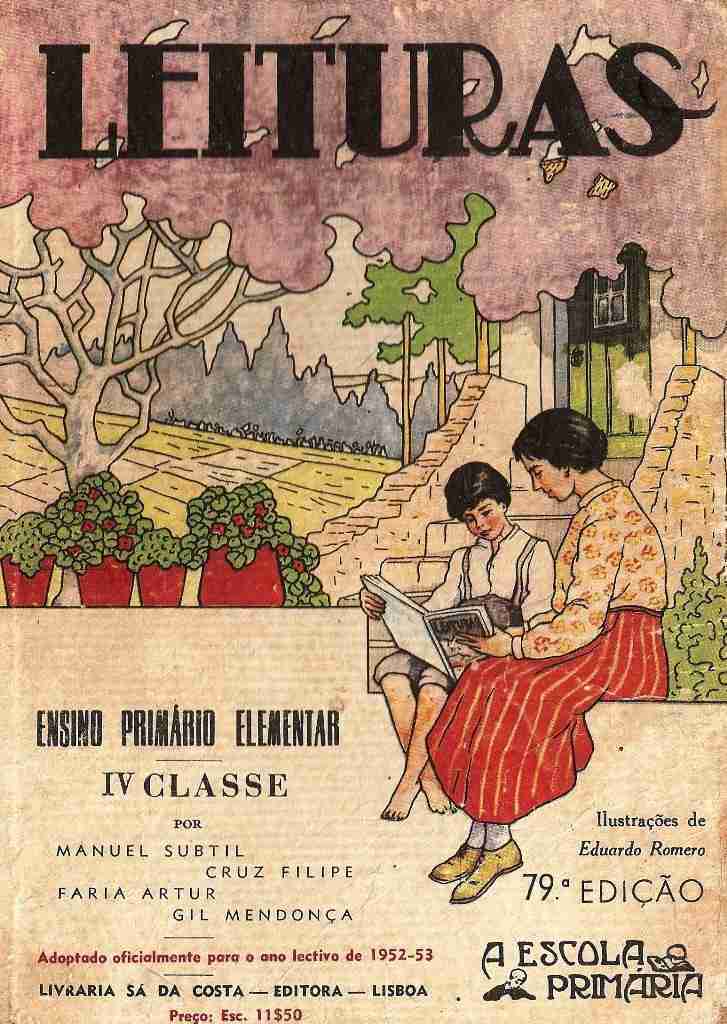
Portuguese Education

Figure 1.--This is the cover of a reading book for the 4th grade. This is the 79th edition, issued in 1952. The 1st edition was issued in 1931. At the time, the 4th rade was the last compulsory school year. The image shows a barefoot boy from an earlier period learm\ning to read with his mother's help.
|
|
Public education began in Europe largely as a result of the Reformation (16th century). It was further by states like Prussia that saw the benefits of educating the populatiin as a whole. This did not occur in Catholic Europe. One of the issues of the Reformation was Bible reading. The Catholic Church discouraged Bible reading among the general public. This there was little support for public education in the countries of southern Europe (Italy, Portugal, and Spain) where the Catholic Church was most influential. The first Portuguese General Decree about Primary Schooling was not apprived until September 7, 1835. At the time about 90 percent of Portuguese population was illiterate. In many villages there were no school and most families didn't think that schooling was important for their children. For this reason the Decree "calls the attention of the family fathers about the duty to send to school their children that reached the age of 7, and asks the municipalities and the parish priests to use any method to persuade the family fathers to accomplish this duty". In spite of this and other decrees the general situation didn't change: many villages had no schools and most Portuguese children never attended school. The problen of course was that the Government offered little financial support for public education. Here not only was the Church hostile, but the country's poverty (in part the result of a poorly educated public) meant that limited resources were available. Portugal became a Republic (1910). The new administration made an effort to promote primary schooling, but there were many difficulties, especially the economic situation of the country and because the traditional attitudes toward education had not changed. The first Portuguese Republic was overthrown with a coup d'état (1926).
The resulting António de Oliveira Salazar dictatorship had a different attitude towards primary schooling. Schools were not to be used as a instrument to promte social ascent. The Salazar Government reduced compulsory school attendance from 5 to 4 years (1927). The new Constitution promulgated in 1933 states that the objective of primary school was only that children can read, write and count. For some time the compulsory schooling was reduced to only 3 years. The attendance of secondary schools by working class children was discouraged. The Government increased compulsory schooling attendahce from 4 to 6 years (1964). A true reform of the Portuguese school system took place only after the "Carnation Revolution" (1974).
HBC

Related Chronolgy Pages in the Boys' Historical Web Site
[The 1880s]
[The 1890s]
[The 1900s]
[The 1910s]
[The 1920s]
[The 1930s]
[The 1940s]
[The 1930s]
[The 1940s]
[The 1950s]
[The 1960s]
[The 1970s]
[The 1980s]
Related Style Pages in the Boys' Historical Web Site
[Long pants suits]
[Knicker suits]
[Short pants suits]
[Socks]
[Eton suits]
[Jacket and trousers]
[Blazer]
[School sandals]
[School smocks]
[Sailor suits]
[Pinafores]
[Long stockings]
Navigate the Boys' Historical Clothing Web Page
[Return to the Main Portuguese education page]
[Return to the Main European school uniform country page]
[Introduction]
[Activities]
[Biographies]
[Chronology]
[Clothing styles]
[Countries]
[Bibliographies]
[Contributions]
[FAQs]
[Glossaries]
[Images]
[Registration]
[Tools]
[Boys' Clothing Home]
Created: 3:55 AM 6/10/2009
Last updated: 3:55 AM 6/10/2009




